ARTICLE AD BOX

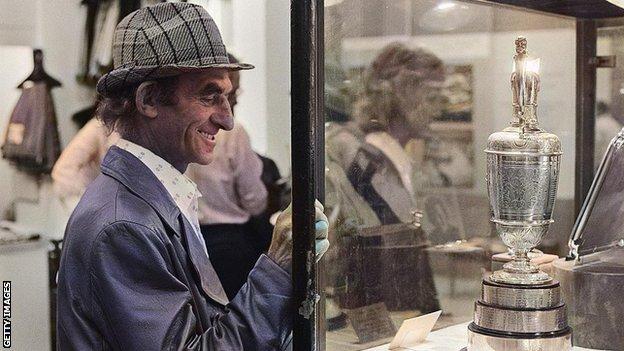 Flitcroft is the subject of a 2022 film, and a 2011 biography, titled 'The Phantom of the Open'
Flitcroft is the subject of a 2022 film, and a 2011 biography, titled 'The Phantom of the Open'The year 1988 will forever be associated with Eddie 'The Eagle' Edwards for British sports fans. But a couple of months after the ski jumper finished last at the Calgary Winter Olympics, another eccentric underdog was heading across the Atlantic.
His name was Maurice Flitcroft. Or Gene Pacheki. Or Gerald Hoppy. Or James Beau Jolley. Or Arnold Palmtree. Or Count Manfred von Hoffmenstal.
Dubbed the 'world's worst golfer', Flitcroft had shot to prominence more than a decade earlier with a record score of 121 in his ill-fated quest to qualify for the 1976 Open Championship. It was an attempt he would repeat several times more, using fake names in an extraordinary game of cat-and-mouse with tournament organisers the R&A.
His efforts piqued the interest of Blythefield Country Club in Michigan, who in the late 1980s invited Manchester-born Flitcroft to play in an event named in his honour.
"We felt it was only appropriate to recognise what we consider to be the more average golfer," said then club professional Buddy Whitten.
They called him Maurice 'the Albatross' Flitcroft, and his remarkable story begins in 1974, back at home on the north-west coast of England.

Watching a golf tournament on his brand-new colour TV in his Barrow-in-Furness living room, Flitcroft was enthralled. He ordered a set of clubs from a catalogue, borrowed instruction books from the library and ambled off to the beach to hit some balls.
He'd been a stunt diver, an ice cream salesman, and an artist. At that time he was working as a crane driver. At the age of 45, now he would be a golfer.
"I took up the game in the autumn of 1974," Flitcroft later said. "I was working full time and didn't have much time to practice that autumn and winter but the following summer I did.
"I read up on the game and about The Open and thought it would be a great tournament to play in. I thought it would be nice to achieve that standard, so that was my plan."
His friend Trevor Kirkwood would remark: "He totally, absolutely thought he could win The Open."
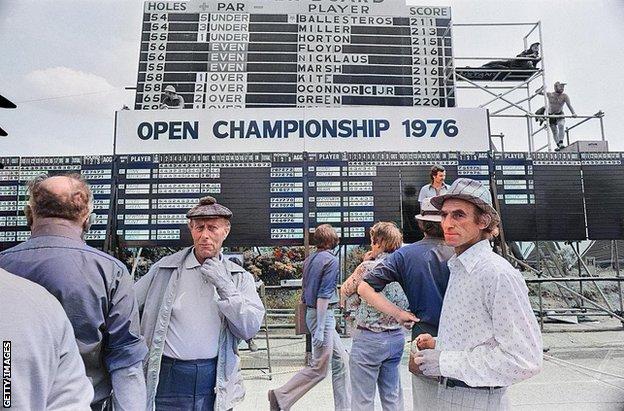 Flitcroft (far right) died at the age of 77 in 2007. His son Gene described him as "a real character" who "loved golf" and was "tremendously popular"
Flitcroft (far right) died at the age of 77 in 2007. His son Gene described him as "a real character" who "loved golf" and was "tremendously popular"Despite still never having played a full round of 18 holes, Flitcroft applied to enter qualifying for the 1976 Open, which was to be played at Royal Birkdale, not far from his home.
The entrance sheet required a box to be ticked next to amateur or professional.
"I entered The Open as a professional," he said. "I couldn't enter as an amateur because I wasn't a member of a club and I didn't have a handicap certificate.
"But I didn't need those things to enter as a professional. My entry was accepted and that was it."
Flitcroft, whose practice had been limited to putting across his living room into coffee cups and playing the odd hole after sneaking onto courses - and invariably being chased off - was sent to a 36-hole qualifying event at Formby. What transpired would scarcely be believable had it not been documented.
He almost missed his tee time, having got lost while driving to the course. So, rather than having time to warm-up on the driving range and putting green, he did what most of us do when turning up for our weekly game and hurried straight to the first tee.
Playing partners Jim Howard and Dave Roberts were waiting.
"Maurice had a set of Harold Bird golf clubs, which were catalogue clubs," recalled Howard, the first black player to become a PGA professional, in a recent interview on the PGA website.
"His mother had bought those for him. And there were 15 of them in his bag. His caddie had to take one back to the pro shop so Maurice had the regulation 14. He was wearing a pair of chinos, a Fred Perry shirt that was ripped at the top and a pork pie hat.
"Dave and I didn't think too much about this. And when he skied his first tee shot and it came down about 20 yards away, we thought it was nerves."
When Flitcroft skewed his second shot into the rough and took two more before his ball reached the opening drives of Howard and Roberts, they sent for an R&A official to check out the rookie pro.
However, the men in suits were powerless to force a player off the course once he had started.
What followed was a "a blizzard of triple and quadruple bogeys, ruined by a solitary par", according to one newspaper report.
By the back nine, word had spread across the course that something unique was happening and a "crowd of two or three hundred people gathered to follow us as a curiosity", said Howard.
"The official total was 121 but it was probably a lot more," he added, explaining that on the par-five eighth - he and Roberts both reached the green in two - "Maurice was in the sand dunes and we didn't know how many shots he took".
A 12 with a question mark was recorded on the scorecard after a player from the group behind said he saw Flitcroft take at least that many shots in the dunes.
"I wasn't at all pleased because that score did not reflect my true ability," said a genuinely disgruntled Flitcroft after his 49-over-par round.
"I should have used the 4-wood, but I left that in the car. I was an expert with the 4-wood, deadly accurate."
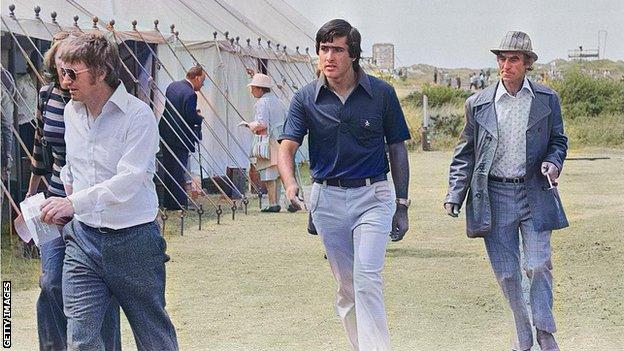 A 19-year-old Seve Ballesteros (centre) would finish second at the 1976 Open, six shots behind Johnny Miller
A 19-year-old Seve Ballesteros (centre) would finish second at the 1976 Open, six shots behind Johnny MillerRealising he would need to shoot 23 in round two to have any chance of qualifying, Flitcroft left Formby and headed home, leaving American postal worker Walter Danecki, who had similarly blagged his way into the 1965 Open Championship, with the record 36-hole qualifying score of 81-over-par 221.
Flitcroft was front and back page news, with headlines celebrating the plucky chancer who had conned the R&A.
But R&A secretary Keith Mackenzie was not amused. Flitcroft was banned from playing.
When he attempted to enter the following year, Mackenzie rebuffed the request, stating the hapless hacker had provided no proof that his game had improved.
The pair continued to correspond via letter, with Flitcroft reportedly challenging the exasperated Mackenzie to a game over the Old Course at St Andrews. The request was, unsurprisingly, denied.
Undeterred, Flitcroft started using aliases to sneak his way in. He tried five more times. The R&A, in their efforts to thwart the persistent player, employed a hand-writing expert to detect his correspondence one year.
He used the names James Beau Jolley (Beau after his dog and pronounced Beaujolais because he "played like a fine red wine"), Arnold Palmtree as a nod to Mr Palmer, and the frankly brilliant Count Manfred von Hoffmenstal.
He managed to get through as Swiss player Gerald Hoppy - Gerald being his middle name and Hoppy a nickname given to him by his mother - and he played nine holes before being rumbled.
"Imagine their surprise when they discovered they had the actual Maurice Flitcroft on their hands," he said.
Flitcroft's stock was high. He appeared on ITV's breakfast show Good Morning Britain and was feted in the United States, where Blythefield in Michigan celebrated his mediocrity with an annual event.
The Maurice G Flitcroft Spring Stag had been set up by Tim Moore in 1978. The event rewarded bad play with golf lessons, bowling balls and goldfish. By the year 2000, two holes were cut into some greens.
In 1987, Tim's brother Terry, a golf writer, was invited to play and "in a haze" after recording a hole-in-one with a one-iron on the par-three 15th, hatched a plan to bring Maurice over to mark its 10th anniversary the following year.
"I spoke with Yorkshire Post golf writer Richard Dodd at the Masters and asked him to check Maurice out for me," Terry tells BBC Sport.
"Richard told me he was 'a harmless eccentric', so I contacted British Airways to see if they'd be willing to fly him over. They loved the idea and also gave me two free business class tickets to use in a raffle."
Maurice and his wife Jean flew to nearby Detroit. According to one relative it was "the first time they'd been out of the house together since the gas oven exploded".
"Their luggage didn't arrive on the same flight so first up we had to go and get them some clothes," said Terry.
"We hit it off well though and they came out to my house for dinner and we took them on a boat on the lake - although that was cut short because Maurice got a bit seasick, which was ironic given he used to be in the merchant navy."
The Flitcrofts' exploits made front page news and several US television stations were sent to cover the golf event.
"He did himself proud at Blythefield," continues Terry. "Lots of people were watching, video cameras were rolling and he hit his first tee shot right down the middle, 200 yards, it was an excellent drive.
"I think the R&A would have been proud of him. He played surprisingly well, with a functional swing and I think he shot somewhere in the high 80s, low 90s. He'd obviously been practising."
Flitcroft was 58 when he played at Blythefield and, buoyed by the experience, he made his final bid to qualify for The Open two years later.
He entered the 1990 championship as Gene Pacheki - reports differ as to whether this was in homage to Danecki or a play on words around the surname, pronounced 'pay cheque'.
He was a respectable three over after two holes before he was discovered and hauled off the course, despite wanting to just finish off the third where he "had a good chance of a par".
It was perhaps an apt ending to his Open career. The eccentric underdog caught again while playing one last game of cat and mouse.

- 'I felt so alone and lost': Michael Sheen lifts the lid on the shocking state of the care system
- What has life as a Rolling Stone been like? The epitome of a rock guitarist, Keith Richards, reveals it all


 2 years ago
42
2 years ago
42

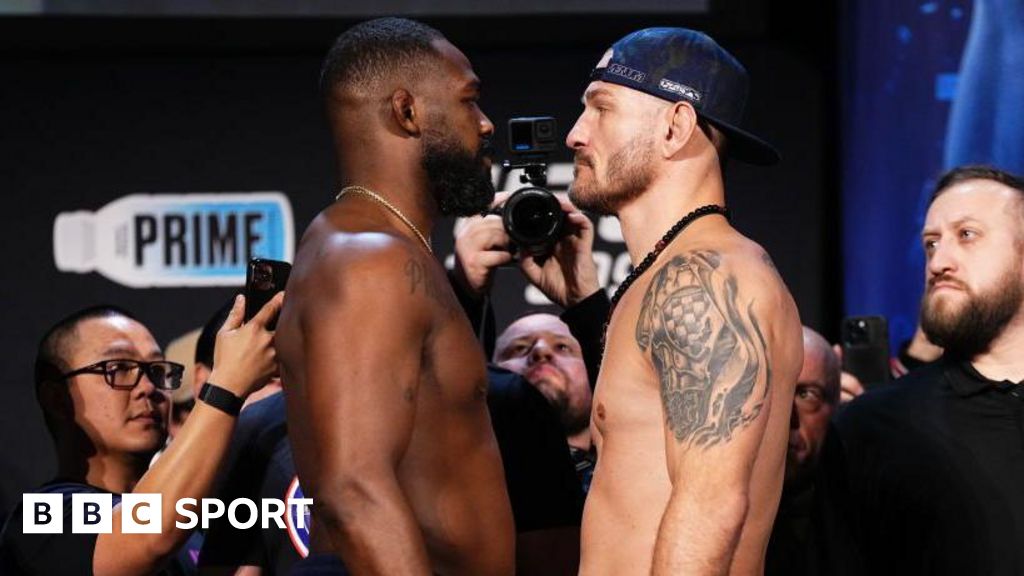
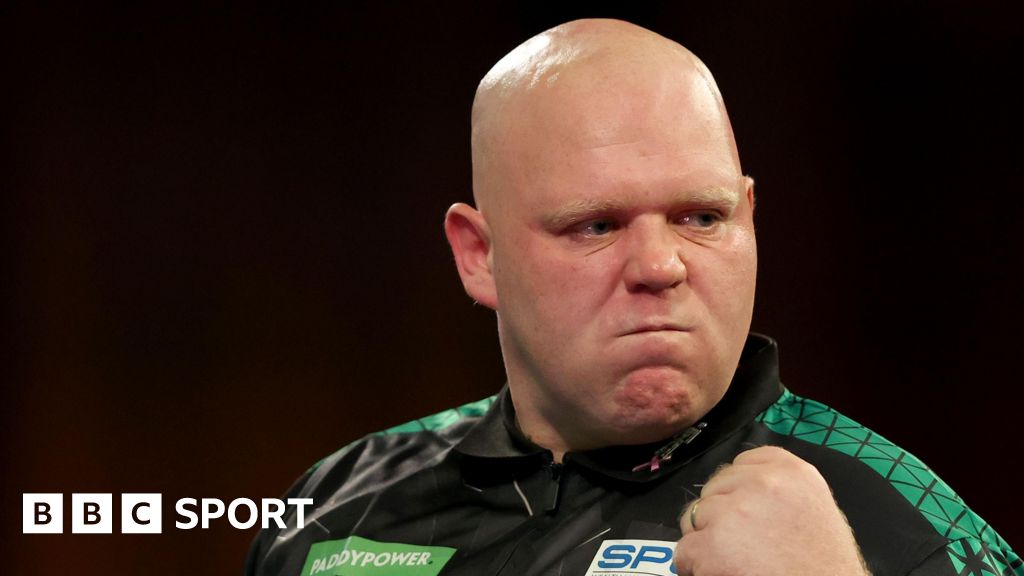





 English (US)
English (US)